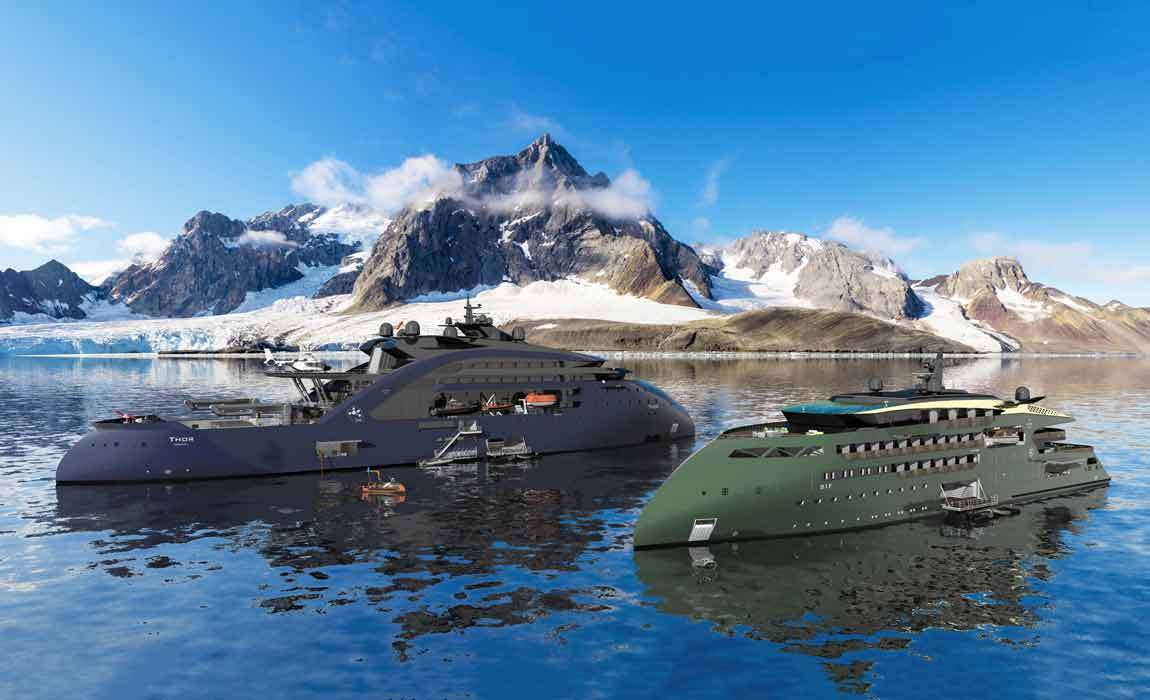This is clearly a BIG LEAP and will not see widespread adoption of "Molten Sodium Reactors" on cruise ships for decades but it is a potentially viable energy source that will allow the cruise - as well as global shipping industry in general - to finally step away from fossil fuels. Instead, we can have safe and reliable electric power generated on board or through the use of replenishment ships like what ULSTEIN is proposing with their latest concept ship.
We've talked about "Shore Power" but now there's a new concept released from marine vessel builder, ULSTEIN that we're going to simply call "Thor Power". Their new concept named the ULSTEIN THOR is a 149m 3R (Replenishment, Research, and Rescue) vessel that will feature a Thorium Molten Salt Reactor to generate enormous amounts of clean, safe, electric power that will enable expedition vessels to operate for longer periods of time in sensitive arctic and antarctic environments than they can currently.
One of the biggest challenges that cruise ships face right now is emissions and so we've started to see a variety of hybrid options being developed for various cruise ships including Hurtigruten who introduced MS Roald Amundsen and MS Fridtjof Nansen with the ability to operate on entirely on battery power for a short amount of time.
In addition to the vessels themselves various other cruise ships are looking at electric options for things like tenders, submarines, and helicopters.
The challenge with all of these options is that there is no way to recharge those batteries without running the mother ship's engines.
That's where ULSTEIN THOR comes in. Since it can remain in place for long periods of time due to it's Thorium reactor, you could concievably have it operate to recharge an electric or hybrid-powered cruise ship during the day so that it could move from spot to spot without powering the diesel engines at all.
This clearly has immediate applications for cruise destinations such as Antactcia and Artcic explorations but there are other places where I'd love to see technology like this enable electric-powered crusie ships to roam, such as the Sea of Cortez and Baja Mexico.
What is A MSR Thorium Reactor?
A MSR / Thorium Reactor is a safe and clean design for small nuclear power stations that dissolves Thorium, an abundant, naturally occurring metal with low radioactivity – in liquid salt. The ensuing chain reaction heats the salt, producing steam to drive a turbine and create electricity. Although developments on land are well documented, its potential for delivering clean maritime power has yet to be incorporated into a vessel design. Ulstein, famed for innovating the revolutionary X-BOW® design, has seen an opportunity to change that, potentially heralding a new dawn of clean power for cruise and maritime operations.
‘Thor’s’ charging capacity has been scaled to satisfy the power needs of four expedition cruise ships simultaneously. ‘Thor' itself would never need to refuel. As such, ‘Thor’ is intended to provide a blueprint for entirely self-sufficient vessels of the future.
The fact that today's nuclear power industry is synonymous with Uranium instead of Thorium is because the earliest driving factors into fission research were driven by a desire to find something extermely explosive with a rapid and potentially uncontrolled reaction to be used for bombs. Thorium though, sits two spots away from Uranium on the Periodic Table and by itself is not fissile.
No matter how many thorium atoms that you pack together, it will not split apart and explode (as we experience with U235). Instead, to create a reaction, we must add a neutron to make it Th233 (vs Th232) and that destabilizes the thorium into protactinium 233 and uranium 233 (the fuel used in conventional nuclear reactors).
The U233 then becomes fissile, releases energy that heats the boilers that generate electricity.
Compared to conventional nuclear reactors, the waste byproduct is only radioactive for 500 years instead of 10,000+ years and the entire process uses a tiny fraction of the amount of fuel so there is also far less waste. Thorium is also three times as abundant in nature and doesn't require enrichment like Uranium does to make it useful for power geneation.
This is obviously a very simplified explanation for a very complex process but the net result is a far more efficient process that is safer to generate power and far better for managing the toxic waste by product too.
Is MSR Power The Future Clean Fuel For Cruise Ships?
Only time will tell if this is the future for shipping but early tests show that it has the potential to eventually replace traditional fossil-fueled large marine vessels such as cruise ships but also cargo ships as well. However, as a technology that is this promising, we hope to see continued research and concept designs.
Right now Thorium technology is being most intensively explored in developing nations such as China and India for large-scale land-based power generation because it offers the same advantages that we've listed above for powering homes and industry as it would at sea.
Unfortunately the specter of anything related to nuclear power still hangs over us. A promising as MSR reactors is, realistically we're decades or more away from it being something we see powering our next arctic exploration ship.
Thanks for reading. We hope this was helpful!
Why stop now?
Participate In Our Polls | Ask or Answer A Cruise Question | Contact Heather to Book Your Next Cruise!

